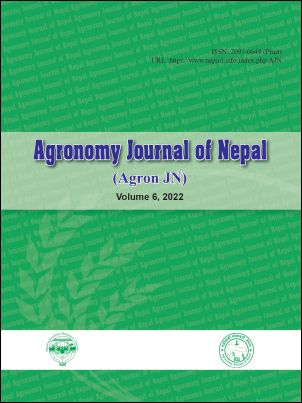Wheat-based Mixed-cropping Evaluation in the River-basin Areas of Far-western Nepal
DOI:
https://doi.org/10.3126/ajn.v6i1.47968Keywords:
Mid-hills, mixed cropping, oilseeds, pulses, river-basin areas, seed rateAbstract
A study was conducted to find-out the optimum seed rate for wheat-based mixed cropping patterns in the research field of the Directorate of Agricultural Research, Bhagetada Doti. The field experiment was conducted in the two consecutive winters of 2019-20 and 2020-21. The recommended seed rate of wheat (120 kg/ha) was considered a check, and the wheat seed rate was reduced by 20, 30, and 40%, respectively, for pea, lentil, and gram, to generate different mixed cropping combinations. The mixed crops were broadcasted together with wheat during wheat sowing time. Chemical fertilizer was applied at the rate of 80:40:30 kg NPK ha-1 at the time of seed sowing, and no additional fertilizers were supplied to the mixed crops. The results revealed that the combination of lentils (30%) and wheat (70%) were found to be the most profitable and recorded the maximum wheat equivalent yield followed by the combinations of toria (30%) + wheat (70%) and toria (20%) + wheat (80%) in our study.
Downloads
Downloads
Published
How to Cite
Issue
Section
License
Copyright (c) 2022 Agronomy Society of Nepal (ASoN)

This work is licensed under a Creative Commons Attribution-NonCommercial 4.0 International License.
ASON permits for free use, distribution and reproduction in any medium if the original work is properly cited and not used for commercial purposes.




